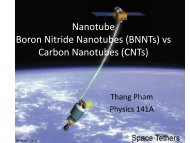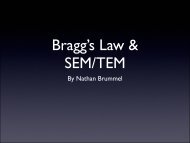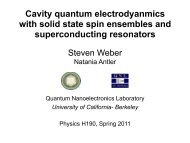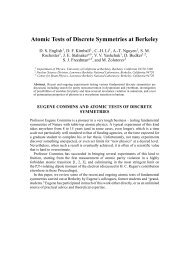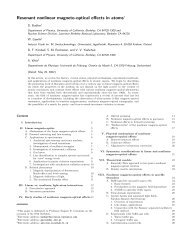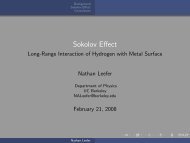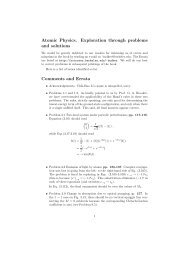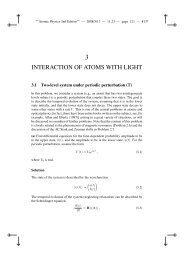Optically polarized atoms_ch_6.pdf - The Budker Group
Optically polarized atoms_ch_6.pdf - The Budker Group
Optically polarized atoms_ch_6.pdf - The Budker Group
You also want an ePaper? Increase the reach of your titles
YUMPU automatically turns print PDFs into web optimized ePapers that Google loves.
<strong>Optically</strong> <strong>polarized</strong> <strong>atoms</strong>Marcis Auzinsh, University of LatviaDmitry <strong>Budker</strong>, UC Berkeley and LBNLSimon M. Ro<strong>ch</strong>ester, UC Berkeley1
Chapter 6: Coherence in atomic systems• Exciting a 0ö1 transition with z <strong>polarized</strong> light• Things are straightforward: the |1,0> state isexcited• What if light is x <strong>polarized</strong> ?2
• Exciting a 0ö1 transition with x <strong>polarized</strong> lightRecipe forfinding howmu<strong>ch</strong> of agiven basicpolarization iscontained inthe field E• x ö1 1 0 1 1E + =− ; E = 0; E− =2 2• Note: light is in a superposition of σ + and σ -3
• Exciting a 0ö1 transition with x <strong>polarized</strong> light• Coherent superposition -|1, |1,-1>+|1,1> 1>+|1,1> is excited• Why do we care that a coherent superposition isexcited?• Suppose we want to further excite <strong>atoms</strong> to a level J ’’4
• Compare excitation rate to J ’’=0for x and y <strong>polarized</strong>E ’ light5
• Compare excitation rate to J ’’=0for x and y <strong>polarized</strong>E ’ light• Calculate final-state amplitude as• with• First, for x <strong>polarized</strong> lightNow repeat for y<strong>polarized</strong> light !6
y <strong>polarized</strong> lightx <strong>polarized</strong> light8
• <strong>The</strong> state we prepared with x<strong>polarized</strong> light E is a brightstate for x <strong>polarized</strong> light E ’• At the same time, it is a darkstate for y <strong>polarized</strong> light E ’• A quantum interference effect !• Two pathways from the initial tofinal state; constructive ordestructive interference• This is the basic phenomenon underlying :‣ EIT electromagnetically induced transparency‣ CPT coherent population trapping‣ STIRAP stimulated Raman adiabatic passage‣ NMOR nonlinear magneto-optical optical rotation‣ LWI lasing w/o inversion‣ “slow light” very slow and superluminal group velocities‣ coherent control of <strong>ch</strong>emical reactions‣ …9
An important comment about bases• We have considered excitation with x<strong>polarized</strong> E light, and have seen an“interesting” coherence effect (dark(andbright) ) excited states• If we <strong>ch</strong>oose quantization axis along lightpolarization, , things look trivialBright intermediate state for z<strong>polarized</strong> light E’Dark intermediate state for x or y<strong>polarized</strong> light E’10
Quantum Beats• Suppose we prepare a coherent superposition ofenergy eigenstates with different energies• For example, we can be exciting Zeeman sublevelsthat are split by a magnetic field• <strong>The</strong> wavefunction will be something like11
Quantum BeatsAs a specific example, again consider exciting xciting a0ö1 transition with x <strong>polarized</strong> light• As a specific example, again consider e• Assume short, broadband excitation pulse att=0. <strong>The</strong>n, at a later time:12
Quantum Beats• Now, as before, we excite further with second cw(but spectrally broad and weak)light field• <strong>The</strong> amplitude of excitation depends on time:13
Quantum Beats• Excitation probability is harmonically modulated• Modulation frequency ↔ energy intervals betweencoherently excited states• <strong>The</strong> evolution of the intermediate state can beseen on the plots of electron density• Note: : Electron density plots are NOT the same asthe angular-momentum probability plots we use alot in this course !14
Quantum Beats• In this case temporal evolution is simple – it is justLarmor precession15
Quantum Beats• Q: What will be seen with y <strong>polarized</strong> light E ’ ?• Q: <strong>The</strong> same but with opposite phasex:y:• Quantum beats in atomic spectroscopy werediscovered in 1960s by E. B. Alexandrov in USSRand J.N. Dodd, G.W.Series, , and co-workers in UK16
Yevgeniy Borisovi<strong>ch</strong> Alexandrov17
<strong>The</strong> Hanle Effect• Now introduce relaxation: : assume that amlitude ofstate J’ decays at rate Γ/2• Amplitudes of excited sublevels evolve accordingto :• With x <strong>polarized</strong> second excitation E’ , we have18
<strong>The</strong> Hanle Effect• Assuming that both light fields are cw, , and thatwe are detecting steady-state state signals as a functionof magnetic field, we have:• Limiting cases:Γ >> 2 ωL; Γ ~2 ωL; Γ
<strong>The</strong> Hanle Effect• What’s s going on is clearly seen on electron-density plot for J’ω = 0 ω = Γ /2LLωL= Γω = 3 Γ /2 ω = 2Γ ω = 5 Γ /2LLLω = 3Γ ω = 7 Γ /2 ω = 4ΓLLL20
<strong>The</strong> Hanle Effect• A similar illustration can be done with angular-momentum probability plots• Quite similar physics takes place in Nonlinear FaradayEffect• Transverse (w.r.t.. magnetic field) alignmentconverted to longitudinal alignment• <strong>The</strong> Hanle effect is sometimes called magneticdepolarization of radiation. ω This refers to observationL= 0 ωL= Γ /2 ωL= Γvia emission from the <strong>polarized</strong> stateω = 3 Γ /2 ω = 2Γ ω = 5 Γ /2LLLω = 3Γ ω = 7 Γ /2 ω = 4ΓLLL21
<strong>The</strong> Hanle Effect• A similar illustration can be done with angular-momentum probability plots• Quite similar physics takes place in Nonlinear FaradayEffect• Transverse (w.r.t.. magnetic field) alignmentconverted to longitudinal alignment• <strong>The</strong> Hanle effect is sometimes called magneticdepolarization of radiation. This refers to observationvia emission from the <strong>polarized</strong> state22





